- Small Dog Place Home
- Health
- Dog Ticks
Dog Ticks: Are You At Risk for Tick Borne Disease?
By Janice Jones |Last Updated 11-22-2021
Even though they may be small, dog ticks are external parasites that suck blood from your dog and you and can cause a variety of diseases including Rocky Mountain spotted fever, Lyme disease, and Ehrlichiosis.
On June 18, 2017, The Washington Post reported that with warming temperatures related to climate change, we are likely to see more vermin including ticks.
Global warming is giving many pests the opportunity to thrive and this spells bad news not only to our dogs but to us as well.
With warming temperatures and milder winters, many areas are seeing a rise in the mice populations because it never gets cold enough to kill them off.
Mice are often the vectors that bring ticks into our homes.
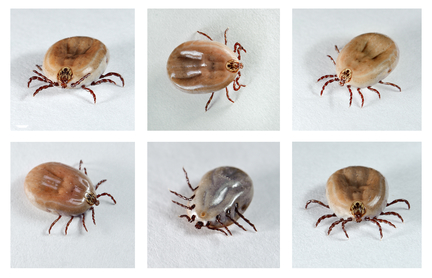
They look like insects, but Ticks are really arachnids, the same family as spiders and scorpions, meaning they have 8 legs instead of the normal 6 legs found in insects.
They do damage to their host by attaching themselves, sucking blood and transmitting disease. The main issue with dog ticks is not the skin problems they cause, but the disease they can transmit.
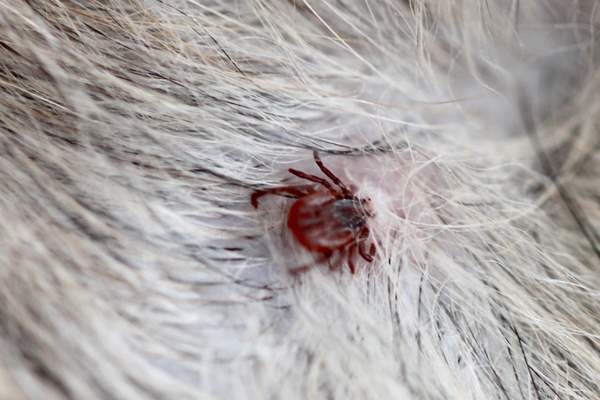 This tick is in the process of embedding itself under the skin. It will then be able to take a blood meal.
This tick is in the process of embedding itself under the skin. It will then be able to take a blood meal.There are several types of ticks that live in North America including the American Dog Tick, the Lone Star Tick, Brown Dog Tick and the Deer or Black Legged Tick.
Each carry different diseases, and if a dog or human is bitten, it is advisable to collect the tick for identification. Rarely anemia is a problem if the dog is severely affected with a major infestation of ticks.
There are four main types of dog ticks found in the United States:
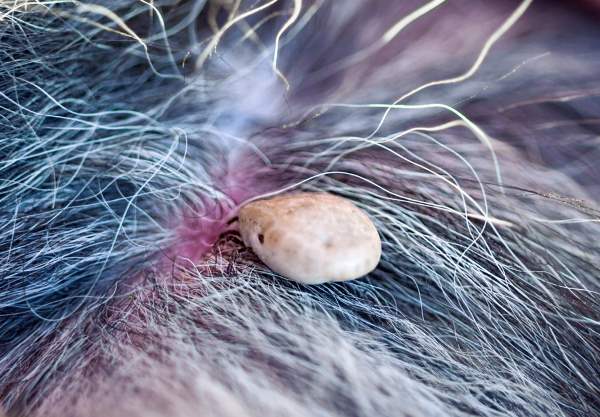 This dog tick has embedded itself under the skin and has begun to take a blood meal which causes the tick to swell.
This dog tick has embedded itself under the skin and has begun to take a blood meal which causes the tick to swell.American Dog Tick
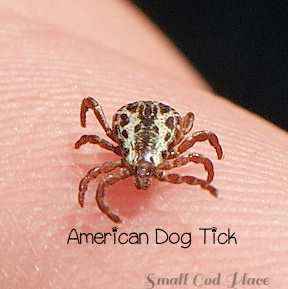
The adult American dog tick is brown with white spots or streaks on their backs. They are found in grassy areas and walkways and trails.
After they have taken a blood meal and become engorged, they appear gray and resemble a bean. They feed on different hosts, including mice, deer, dogs and people.
The nymphs and adults can transmit diseases such as Rocky Mountain spotted fever and Tularemia. These ticks can survive for up to 2 years in any stage if no host is found.
Lone Star Tick
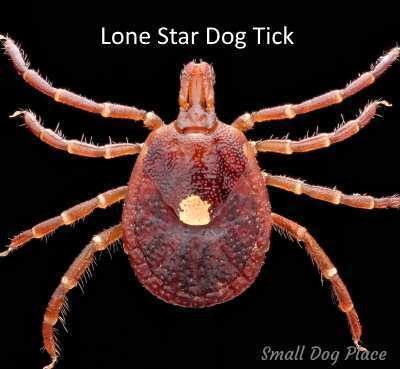
Lone Star ticks can bite dogs, cats, and humans. The adults are tan or brown, and you can observe a white spot on the back.
These ticks live in woodland areas and are most commonly found in areas along creeks and river bottoms where animals like to rest.
The larvae don’t carry any diseases, but the nymph and adult stages transmit the diseases Ehrlichiosis, Rocky Mountain Spotted Fever and Stari Borreliosis.
Brown Dog Tick
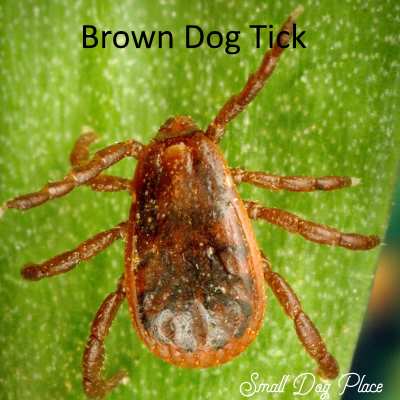
This is a relatively harmless tick which attaches to the dog and sometimes though rarely to people.
They are also known as a house or kennel tick because it can survive and develop through its lifecycle indoors. You are most likely to find this tick in kennels or homes where many dogs live.
The good
news about this type of tick is that it does not carry any known diseases.
Deer or Black-legged Tick
This is the tick that carries diseases including Lyme Disease, Babesiosis and Ehrlichiosis. They like to attach to dogs, cats and even people.
They look like the brown dog tick, but they are deeper darker brown in color. The Deer tick nymph stage resembles poppy seeds on yours or your dog’s skin.
If you live in the northeastern part of the US, and you get bit by a tick in the Fall or Winter, you may be dealing with the Blacklegged tick.
Approximately 50% of adult Blacklegged ticks are infected with the Lyme bacteria, so this tick is definitely one to be concerned about.
These are the most common types of ticks, but Companion Animal Parasite Council reports that there are a least eight species of dog ticks including:
Amblyomma americium (Lone star tick)
Amblyomma maculatum (Gulf Coast tick)
Dermacentor variabilis (American dog tick)
Dermacentor andersoni (Rocky Mountain Wood Tick)
Ixodes pacificus (Western black-legged tick)
Ixodes scapulars (Black-legged tick)
Otobius megnini (Spinose ear tick)
Rhipicephalus sanguineus (Brown dog tick)
Where do Dog Ticks Live?
Ticks hang out in wooded areas often in tall grass waiting for a warm blooded animal to pass.
Once a suitable host is found, they will attach themselves and feast on the blood of its host. They will not drop off until their meal is complete.
Some ticks will feed for hours or even days. Ticks particularly like the areas on your dog where there is less hair: around the ears, between skin folds, between toes, and inner legs.
Although the signs of tick infestation can mimic other skin conditions, you are likely to notice scratching or shaking of the head, chewing on the feet or biting on the hindquarters.
If nothing is done, hair loss, red scaly flaking skin and hot spots develop. If you notice any of these symptoms, it is time to check your dog for external parasites.
Life Stages of the Dog Tick
Most ticks go through four distinct stages: egg, larvae, (practically microscopic in size and have 6 legs) nymph, (about the size of a pin head and have 8 legs) and adult (larger with 8 legs).
Except for eggs, all stages of the tick will attach to the host (dog or you) for a blood meal, and this is necessary for the tick to mature to the next life stage. Adult female ticks can lay thousands of eggs at one time.
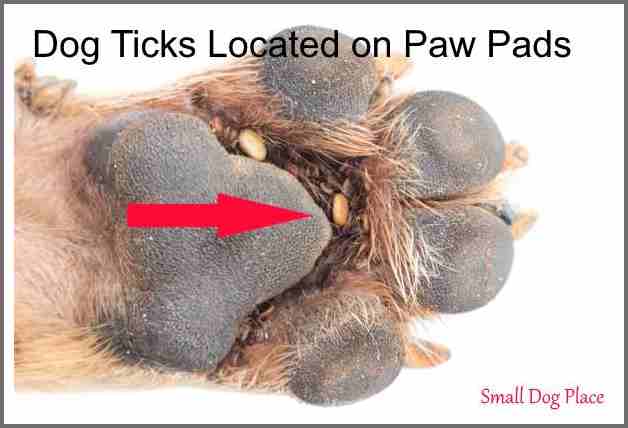
Why worry about Dog Ticks
"Forty to 90 percent of white-footed mice carry Borrelia burgdorferi, the spirochete bacterium that causes Lyme disease, and they provide the first blood meals for blacklegged ticks, also known as deer ticks, which can transmit the disease to humans."
Washington Post
If that isn't scary in and of itself, ticks are also responsible for many other problems:
- Skin Infections
- Ehrlichiosis
- Lyme Disease
- Rocky Mountain Spotted Fever
- Hot Spots
- Tick Paralysis
- Rarely—anemia due to loss of blood
How to Remove a Tick
You don’t need to rush off to the vet to have a tick removed from your dog. It is easier than you think.
You will need:
- Pair of gloves
- Clean pair of pointy tweezers
- Antiseptic such as Hydrogen Peroxide
- Isopropyl alcohol
To Remove a Tick:
It is best to wear plastic gloves if you have them available. Using your tweezers, grasp the tick as close as you can to the dog’s skin without pinching the skin.
Pull slowly and outward in a steady motion, making sure you remove the entire tick. If the head part is still attached, it can cause infection. That is why it is necessary to pull slowly. If you're using a tick remover:
Add a little isopropyl alcohol or rubbing alcohol in a container. Drop the tick into the container and mark the date on the container. The alcohol will kill the tick.
As long as your dog does not show any signs or symptoms of the disease, you are finished. However, it the dog begins to appear sick, you will want to call your vet and have the tick available for identification.
Can People Get Diseases from their Dog's Ticks?
This is an excellent question but a little tricky to answer. People do get diseases from ticks but they don't get the disease from their dog. They get the disease directly from being bitten by a tick that carries a disease.
Diseases such as Rocky Mountain Spotted Fever and Lyme Disease are diseases that affect both dogs and their owners.
Tick Prevention
It is very difficult to prevent ticks from attaching to your dog if he or she spends time outdoors in areas where ticks live.
Whether it is your backyard, a neighborhood walk, hike in the woods or an overnight camping trip, ticks can be present. The best prevention is to check your dog regularly after outdoor activity and remove the tick promptly if observed.
If ticks are a problem in your area, you can use an outdoor yard spray to keep them out of your yard. Backyards that are clear of woods are less likely to be infested.
A fence can help if your property butts up to a forested area, but you will want to create a physical barrier such as a three foot strip of gravel or mulch between your property and the forest.
Reference and Further Reading
A great resource for identifying ticks in all of their life stages can be found at a site provided by the University of Rhode Island:
Tick Encounter Resource Center: http://www.tickencounter.org/tick_identification
About Janice (author and voice behind this site)
Janice Jones has lived with dogs and cats for most of her life and worked as a veterinary technician for over a decade. She has also been a small-breed dog breeder and rescue advocate and holds academic training in psychology, biology, nursing, and mental health counseling. Her work focuses on helping dog owners make informed, responsible decisions rooted in experience, education, and compassion.
When not writing, reading, or researching dog-related topics, she likes to spend time with her six Shih Tzu dogs, her husband, and her family, as well as knitting and crocheting. She is also the voice behind Miracle Shih Tzu and Smart-Knit-Crocheting
Does This Article Deserve Your Thumbs Up?
We always appreciate your support and encouragement. Your thumbs up means so much to us. Please like this article.
If you find this page or any page on Small Dog Place Helpful, or useful in anyway, I'd love it if you would click the small heart found on the bottom right of each page.
You can also share or bookmark this page -- just click on the:

Free Monthly Newsletter
Sign Up for Our Free Newsletter and get our Free Gift to You.
my E-book, The Top 10 Mistakes People Make When Choosing a Dog (and how to avoid them)

